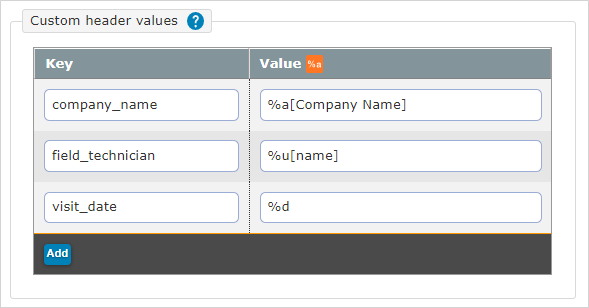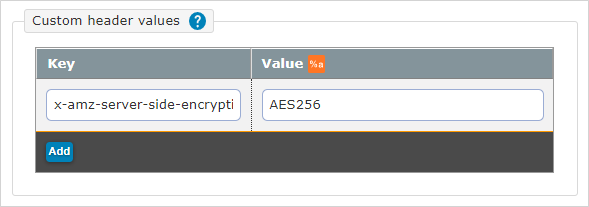Amazon S3 Data Destination
Available on the Enterprise tier only:
About
The Amazon S3 data destination sends submitted forms to an Amazon S3 bucket. Create custom file and folder names based on data in the form to logically organize and manage files.
Data destinations automatically back up data collected in the field. They reduce the need to visit the web portal by making submitted forms available through the services you already use. Different documents can also be sent to different services with a single form submission. Read here for more information on data destinations.

|
Amazon S3 (Simple Storage Service) is an online storage service that allows users to store and retrieve data from anywhere, at any time. |
Connection
Bucket Name
Objects in S3 are organized into "Buckets." Enter the name of an existing bucket. TrueContext cannot create new buckets in S3.

Connection Configuration
Note:When you set up a Connection for an Amazon S3 Data Destination![]() A Data Destination specifies where to send data from a submitted form. You can use Data Destinations to automate data sharing and storage, routing data to a specific service (such as email or cloud storage) in several different formats., you must create credentials under an IAM user. Give the IAM user write access to the bucket and key prefix that you set up for your destination.
A Data Destination specifies where to send data from a submitted form. You can use Data Destinations to automate data sharing and storage, routing data to a specific service (such as email or cloud storage) in several different formats., you must create credentials under an IAM user. Give the IAM user write access to the bucket and key prefix that you set up for your destination.
Set up an Amazon Web Services Connection or use an existing connection. To set up an Amazon S3 Data Destination, your AWS account must have the s3:PutObject IAM permission.

Custom Header Values
Attach custom metadata to the document sent to S3. Metadata consists of key: value pairs that belong to files. For example, an invoice document may have a key:value pair of invoice_id: %r[id]
- Key: Enter static text.
- Value: Value expressions usually include Data Reference Expression Language. Use data from submitted forms as the value; collect the answers to specific questions with Unique IDs.

Amazon S3 Server-Side Encryption (SSE)
Amazon Web Services can handle the encryption and decryption of your S3 objects for you with Server-Side Encryption (SSE); strong multi-factor encryption using 256-bit Advanced Encryption Standard (AES-256) encrypts your data and there is no need to manage your own encryption keys. Decryption happens automatically when you retrieve data from your S3 bucket.
Request that your TrueContext-submitted data is encrypted by adding a request header to your data destination configuration. Under Custom Header Values, enter x-amz-server-side-encryption as the key and set the value to AES256.

File Configuration
Send attachments in separate files, alongside the Data Record Document.
Optionally choose to send attachments (images, signatures, barcodes, etc) as separate files.
Folder Expression
This is the folder your documents will be sent to. If the folder doesn't exist yet, it will be created.
- Single folder: Enter the folder name. For a folder named "Inspections", enter "Inspections".
- Multiple folders: Use Data Reference Expression Language.
- %f - to sort submissions into folders named after the form.
- %u - to sort submissions into folders named after the user submitting the form.
- %a[Unique ID
 A Unique ID refers to the specific identifier of a question, form page, form section, or Data Destination. Unique IDs are used as reference points when pulling data for conditional logic, Analytics projects, Data Destinations, and Documents.] - to sort submissions into folders named with the answer to a chosen question. Read more about Unique IDs.
A Unique ID refers to the specific identifier of a question, form page, form section, or Data Destination. Unique IDs are used as reference points when pulling data for conditional logic, Analytics projects, Data Destinations, and Documents.] - to sort submissions into folders named with the answer to a chosen question. Read more about Unique IDs. - Optionally add static text for formatting - eg. "%f -- %a[Customer Name]"
Testing and Troubleshooting Data Destinations
Data destinations should be configured and tested carefully before using them in production. This is key to ensuring that TrueContext data is received correctly. Please consult the recommendations for testing and troubleshooting data destinations.